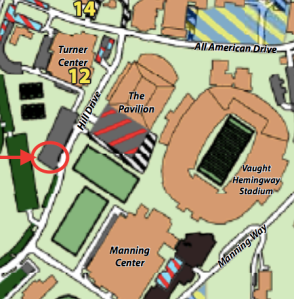The University of Mississippi Department of Parking and Transportation is now offering “carpool-only” parking spots for commuter and faculty and staff parking permits. There are 10 of these spots available to students, faculty and staff who drive to campus with two or more passengers in the car. The spots are located on the south end of the faculty and staff parking lot across from the Pavilion.
The “carpool-only” parking slots were created for the 2017-2018 school year as a trial run. Depending on the success of the spots, Parking and Transportation may create more “carpool-only” parking spots to expand options and help reduce traffic congestion on campus.
The growing student population has made parking on campus an ongoing challenging that the Department of Parking and Transportation is continuously trying to alleviate. Enrollment at Ole Miss has grown by 40.5 percent over the past decade, reaching an all-time high of a total of 24,250 students in the fall of 2016. Almost 20,000 students are located on the Oxford campus.
Last fall, Ole Miss Associated Student Body Vice President Elam Miller and Hunter Myers, co-director of university boards and committees, came up with the idea of creating “carpool-only” parking spots for commuter students to help with the ongoing parking issue.

“Our hopes behind creating the ‘carpool-only’ parking spots are to free up more commuter parking spots to fix the tight parking situation,” Miller said. “We wanted work to reduce traffic congestion and to reward people for carpooling to campus by making it easier to find quick and easily accessible parking spots.”
Miller said he and Myers worked through the idea and the possible conflicts of the carpool option. Once they figured out solutions to the possible problems with the ideas, they then presented it at an Active Transportation Advisory Committee meeting.
“We had been toying with the idea of ‘carpool-only’ parking spots for about two years, but we kept facing obstacles with the idea,” Mike Harris, director of parking and transportation, said. “Once Elam and Hunter presented their ideas with carpool parking and their plan of action, it was easy to put the motion into effect.”
The “carpool-only” parking spaces are each clearly marked by green signs. In order to monitor the “carpool-only” parking spots, Parking and Transportation security checks the video surveillance of the parking lot hourly to ensure drivers are following the carpool rule. If security staff only sees one person get out of the vehicle, it will issue citations when needed. The carpool trial required no additional funding because the department already had video cameras for surveillance of all the parking lots on campus.
“In addition to creating more and easily accessible parking spaces, the ‘carpool-only’ parking spots are also better for the environment, which is a plus,” Myers said. “By only bringing one car to campus instead of two or three, people are reducing pollution and greenhouse gases in the air.”
These parking spots have been successful so far. Senior Riley Kole utilizes the carpool option on campus, as she and her roommate ride together to class every Monday and Wednesday.
“Parking on campus can be hard and stressful,” Kole said. “The carpool option makes getting to class and finding a parking spot so much easier because of the availability and convenience of the location.”






